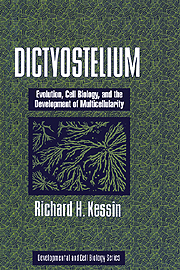Book contents
- Frontmatter
- Contents
- Preface
- 1 A Brief Introduction to Dictyostelium discoideum and its Relatives
- 2 A History of Research on Dictyostelium discoideum
- 3 The Evolutionary Biology of Dictyostelium
- 4 The Genome and Genetics
- 5 Membranes and Organelles of Dictyostelium
- 6 Cell Motility and the Cytoskeleton
- 7 The Transition from Growth to Development: From Starvation to Self-Sustaining cAMP Signal Relay
- 8 Chemotaxis and Aggregation
- 9 Differentiation and Adhesion in the Aggregate
- 10 The Behavior of Cells in the Slug
- 11 Culmination
- 12 Formation and Germination of Spores
- 13 Resources
- References
- Index
- Plate section
5 - Membranes and Organelles of Dictyostelium
Published online by Cambridge University Press: 07 October 2009
- Frontmatter
- Contents
- Preface
- 1 A Brief Introduction to Dictyostelium discoideum and its Relatives
- 2 A History of Research on Dictyostelium discoideum
- 3 The Evolutionary Biology of Dictyostelium
- 4 The Genome and Genetics
- 5 Membranes and Organelles of Dictyostelium
- 6 Cell Motility and the Cytoskeleton
- 7 The Transition from Growth to Development: From Starvation to Self-Sustaining cAMP Signal Relay
- 8 Chemotaxis and Aggregation
- 9 Differentiation and Adhesion in the Aggregate
- 10 The Behavior of Cells in the Slug
- 11 Culmination
- 12 Formation and Germination of Spores
- 13 Resources
- References
- Index
- Plate section
Summary
Embryonic cells are spared some of the tasks that confront soil amoebae. Multicellular organisms are protected from direct contact with the environment because they are part of a large mass with specialized external epithelia. The plasma membrane of soil amoebae offers none of the protection of a multicellular organism. Every time it rains, the osmotic shock to the cells will be severe, because rainwater is essentially distilled water and like other single-celled organisms, D. discoideum and its relatives must be equipped to handle sudden changes in osmolarity. Other conditions, for example hyperosmotic mud, lead to hypertonic shock, for which the cells also have adaptive mechanisms. The internal membranes and organelles resemble those of higher organisms. Many of the membrane compartments of the amoebae can be marked by fusing the green fluorescent protein (GFP) gene to genes that code for appropriately targeted proteins. This useful property is illustrated in Plate 1.
The plasma membrane
The plasma membrane must be capable of movement on a variety of surfaces that constitute the matrix of the soil, whether the cellulose of decayed leaves, minerals, decaying vegetable matter, or films of bacterial growth. These cells must have substrate adhesion systems that are more versatile than those of embryonic cells, which move on a defined extracellular matrix. The amoebae eat all manner of bacteria and yeasts, and even undertake the occasional act of cannibalism, so several mechanisms of cell recognition must be deployed on the membranes.
- Type
- Chapter
- Information
- DictyosteliumEvolution, Cell Biology, and the Development of Multicellularity, pp. 59 - 69Publisher: Cambridge University PressPrint publication year: 2001
- 1
- Cited by



